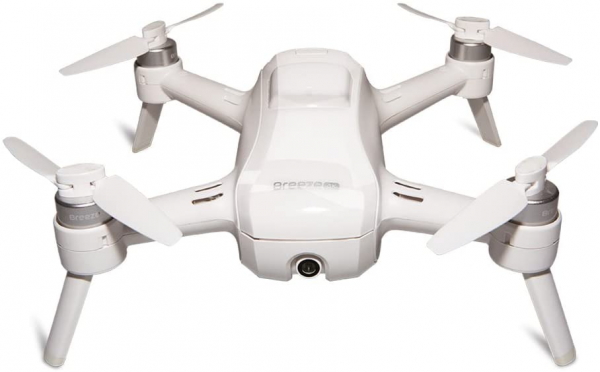Yuneec
Yuneec Breeze 4K: the pocket drone dedicated to selfies
Aprox. 384€
See specificationsYuneec, an electric aviation specialist, presented this year at IFA the Breeze 4K, a drone dedicated to selfies, compact, designed for beginners and capable of filming in 4K. Positioned at € 499, it comes to hunt on the land of the Parrot Bebop 2 and the Xiro Explorer Mini, but does it have as many advantages?
Positive points
Silhouette.
Shoot in 4K.
Compact.
Stable indoors.
Ability to share images directly.
Bad points
Finish.
4K not stabilized.
Full HD limited to 30 fps.
Photo quality.
Limited performance.
Repetitive and overly self-centered flight modes.
Autonomy.
Lack of versatility.
Price.
Our review
Presentation
The drone market continues to grow and the market begins to segment into specialties. The Yuneec Breeze 4K is one of the pocket drones that you can easily take with you and which are especially thought for the selfie or the shooting in height of a landscape, but really get away from it. flight point. Moreover, Yuneec is banking on compactness, 4K and ease of use. Will these characteristics be sufficient to convince? Answer in our test!
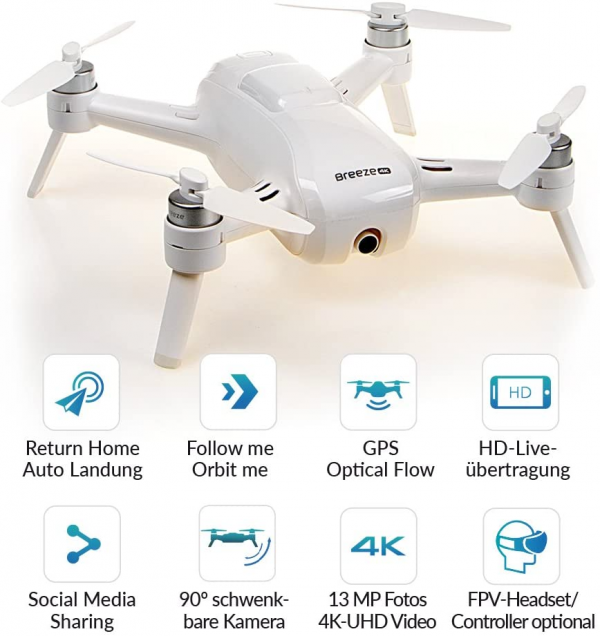
Getting started
Since we became interested in drones, it has to be said that great efforts have been made in terms of silhouette and general design. The Breeze 4K has indeed a good boil and its pace gives it a pleasant profile, far from the DIY quadcopters at the bottom of a passionate garage or the Cicada tested in July in our columns. Do not think the Breeze is a monument of elegance, but even next to the bestseller of the moment, the Parrot Bebop 2, its appearance is more pleasant. When taken in hand, the feeling is nevertheless more mixed. We stay on a hard plastic assembly with a central part with a shiny coating and matt arms, but the whole reveals a little play and especially some unpleasant creaks. The hollow plastic to reduce the weight is not for nothing and we are ultimately a little disappointed by this lack of density.
With a weight of 385 grams and dimensions of 196 x 196 x 65 mm (L x W x H) its four brushless motors allow it to fly at 80 m in height within a radius of 100 m. Its 11.1 V and 1150 mAh 3S Lipo battery promises 12 minutes of flight and it is capable of splitting the wind at 5 m / s in horizontal speed and 1 m / s in upward speed. Values which almost make it pass for a snail beside the surprising performances of Bebop 2, but which are justified by a different use. The Breeze 4K is not a disguised racer and has no ambitions. Its self-portrait orientation is fully assumed and the purpose of the Breeze 4K is much more to film you than to introduce you to the joys of piloting. In short, it is a flying selfie stick capable of filming in 4K. A comparison which is not trivial, since the size of its CMOS sensor of 1 / 3.06 "approaches that of the smallest sensors of smartphones; the Samsung Galaxy S4 had, for example, a sensor of 1/3, 04". Not enough to cover it with stigma as the Breeze has some interesting advantages, starting with a remarkable stabilization in flight which allows it to fly indoors without GPS very easily.
The connection with the Breeze is done very simply via the Wi-Fi of the smartphone. When launching the Breeze Cam application, downloaded from the Apple Strore or the Play Store for Android, it is possible to rename it and then adjust the various flight parameters, such as speed, flight height and distance maximum at which it moves away from us on takeoff. Particular point of the Breeze, the commands are reversed in the standard mode (mode 2). Indeed, since this drone is primarily intended for taking self-portraits, the classic flight position is the camera pointed at the pilot. However, it will be possible to reverse the controls and regain normal control.
The main screen allows you to choose between a flight mode or reading and sharing images for networks. There are 5 flight modes:
Selfie Mode allows you to take a selfie.
Pilot Mode allows manual piloting in a classic way with the gas, roll and drift controls.
Orbit Mode circles around the pilot while filming.
Journey Mode automatically removes the pilot's Breeze by gaining altitude to reveal the surrounding landscape.
Follow Me allows the Breeze to follow the GPS of the smartphone.
As you can see, there are some redundancies between Selfie, Orbit and Journey modes ... modes in which "me", "I", and "my own person" are at the center of the action; the essence of the selfie what ...
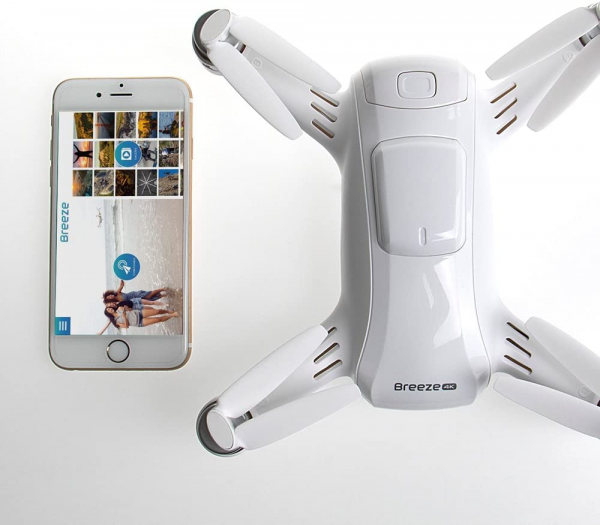
Flight
The installation of the Breeze on its takeoff point is childish. You just need to make sure that the manually retractable landing pads are fully extended and that the propellers, also retractable, are unfolded. Once the connection has been made and the flight mode has been chosen, the take-off button is pressed and the Breeze takes off. Despite its low weight and compactness, the stability is remarkable. The coupling of the GPS action with the infrared and optical sensors placed under the belly of the craft provides real support for the Breeze, which does not move an iota ... when there is no wind. Suddenly, the indoor flight is also very stable and we take to make some takeoffs in the living room or in the office to the great despair of colleagues ... However, as soon as the wind blows beyond 10 km / h, that's another story and orders are losing precision.
Stabilization does what it can and a few pendulum effects disrupt steering. The different flight modes work well; note that the Follow Me mode follows the phone's GPS and not the subject. Suddenly, we can quickly find ourselves outside the frame or too close to the edge. The other modes are also functional and fun, but we regret the absence of a Way Point which would allow the drone to make an automated trip in the pilot's environment. Finally, in classic flight mode, as written above, do not expect the thrill.
The limited performance allows the Breeze to take a few high shots or to move away, but only within a range of 100 m. Note, however, that it is possible to use the phone's Gyroscope to control it, provided you keep the blue button located to the right of the controls. Landing is done simply by pressing the dedicated key or by ordering a Return to Home. Obviously this function is only active outdoors with the satellites detected.
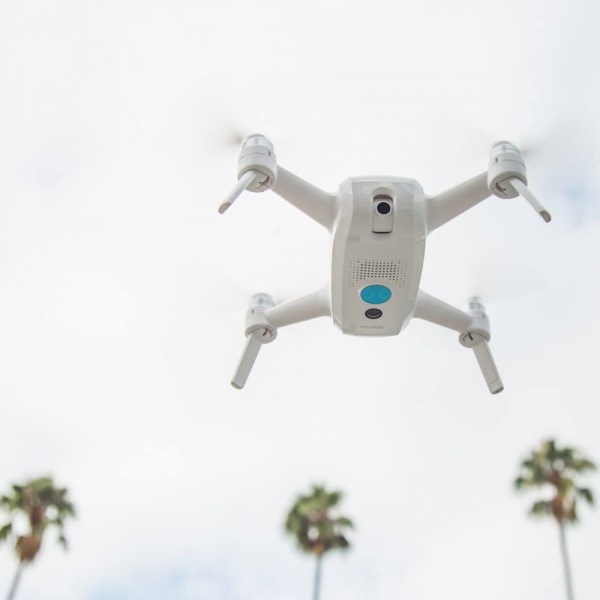
Image quality
With such a small CMOS sensor of 1 / 3.04 "and 12 Mpx, do not expect a breathtaking image quality. In the photo first, it seems to find the image of a smartphone d" A few years ago. The colors are too dull, the image lacks sharpness, the details are smoothed, even more when you move away from the center. We also notice a visible swarming from the lowest sensitivities.
In video it's better, especially for the web, but it's better to just watch the image on your smartphone or tablet. The sensor is capable of delivering videos not stabilized in 4K 2160p at 30 fps or stabilized in Full HD 1080p at 30 fps and in HD 720p at 60 fps. Said stabilization is only software and it has a lot to do when the drone makes sudden movements or the wind blows. In Full HD, the image has poor dynamics, not enough detail and too dull color rendering. In 4K, it's a good surprise: the image is both more contrasted and more detailed. In both cases, we regret the rate limited to 30 fps, which limits the capture of moving subjects.
12 MP photo test scene
4K video extract of the test scene
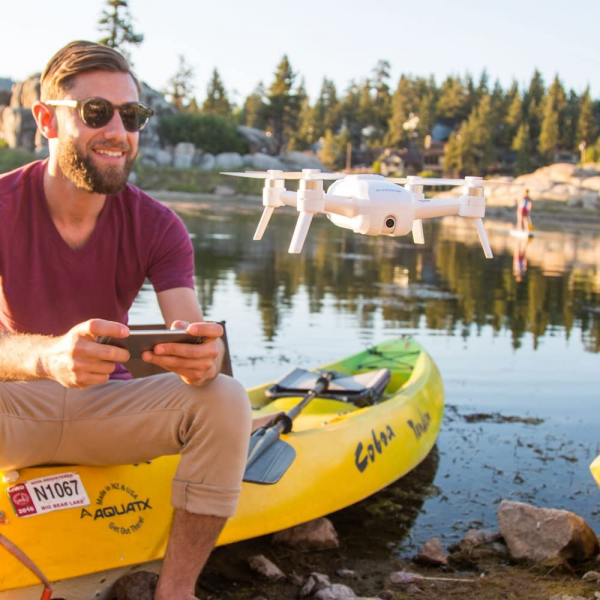
Autonomy
Autonomy is one of the big weaknesses of the Yuneec Breeze 4K. If it is established well between the 10 and 12 minutes announced, that remains too little. Indeed, in addition to the fact that the Parrot Bebop 2 reaches 25 minutes of flight, we cannot lose sight of the fact that the Breeze 4K is an even more general product and there is a good bet that the neophytes will get lost a little in the drone settings at the start. Suddenly, the time to grope, to try one or two self-portrait modes then finally switch to Pilot mode and you will have to land. As for experienced users, they will quickly be frustrated that they can only chain three or four flights of two or three minutes each time, not to mention that the battery melts visibly as soon as the wind picks up.
Conclusion
Do not take it for what it is not! The Yuneec Breeze 4K is an unpretentious little drone capable of taking original self-portraits. If you are looking for a drone delivering piloting sensations, go your way, it is not versatile. On the other hand, if you want a flying and fun selfie stick in secure environments, the Breeze 4K is for you.
Specifications

